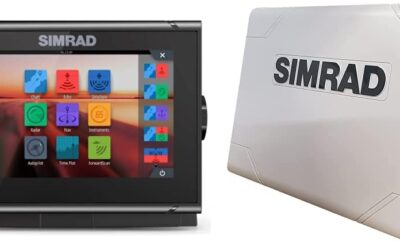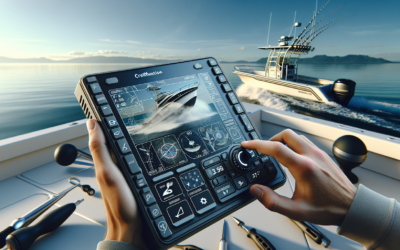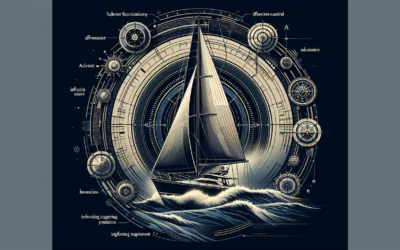Imagine you’re out on the open water, casting your line and waiting eagerly for a bite. But what happens when you catch a fish that you want to release back into the wild? That’s where fish finders come in. In this article, we’ll explore the invaluable role that fish finders play in helping us practice responsible fishing by providing us with the tools and techniques to safely catch and release fish. It’s time to become a pro at catch and release strategies with the help of your trusty fish finder!
Overview of Catch and Release
Importance of Catch and Release
Catch and release is a crucial practice in recreational fishing that involves catching a fish and releasing it back into the water unharmed. This practice not only ensures the sustainability and conservation of fish populations but also promotes the preservation of our precious ecosystems. By allowing fish to be caught and released, anglers can enjoy the thrill of fishing while minimizing the impact on fish populations.
Advantages of Catch and Release
Catch and release has numerous advantages for both anglers and the environment. Firstly, it promotes sustainable fishing practices by maintaining healthy fish populations, ensuring that future generations can also enjoy fishing. Secondly, it allows anglers to target larger and older fish, as they are often the breeders and contribute to the genetic diversity of the fish population. Additionally, catch and release helps to preserve the delicate balance of ecosystems by minimizing the disruption caused by excessive fish removal.
Role of Fish Finders in Catch and Release
Fish finders play a vital role in catch and release strategies as they enable anglers to locate fish more efficiently. These devices utilize modern technology, such as sonar, to detect and display underwater objects, including fish. By using fish finders, anglers can identify fish-rich areas and make informed decisions about where to cast their lines, increasing their chances of success while reducing the time fish spend out of the water.
Understanding Fish Finders
Introduction to Fish Finders
Fish finders are electronic devices specifically designed to assist anglers in locating fish underwater. They utilize various technologies, including sonar, GPS, and imaging, to provide real-time information about the underwater environment. Fish finders have become an indispensable tool for both amateur and professional anglers, enabling them to improve their fishing efficiency and success.
Types of Fish Finders
There are different types of fish finders available, each with its own features and capabilities. The most common types include standalone fish finders, combo units, and portable fish finders. Standalone fish finders are dedicated devices that solely focus on fish detection. Combo units, on the other hand, combine fish finding capabilities with GPS and chartplotters, allowing anglers to navigate and mark fishing spots. Portable fish finders are compact and easy to carry devices, making them ideal for anglers who frequently fish from various locations.
Components of Fish Finders
A typical fish finder consists of several key components that work together to provide essential information. These components include a display unit, transducer, power source, and often a GPS module. The display unit is where the information is presented, and it can range from small screens to large, high-definition displays. The transducer is responsible for emitting and receiving sonar signals, providing data about the underwater environment. Power sources can vary from batteries to wired connections, ensuring uninterrupted operation. Some fish finders also include GPS modules, enabling anglers to mark specific fishing spots and navigate with ease.
Selecting the Right Fish Finder
Consideration Factors
When selecting a fish finder, there are several factors to consider based on your fishing needs and preferences. Firstly, determine whether you require a standalone fish finder or a combo unit with additional features like GPS. Consider the size and resolution of the display unit, as it impacts the visibility and clarity of the information. Transducer type and frequency are also important, as they affect the depth and coverage range of the fish finder. Finally, take into account the power source, durability, and user-friendly interface of the device.
Key Features to Look for
While choosing a fish finder, there are specific key features that can greatly enhance your fishing experience. Look for devices with advanced sonar technologies, such as CHIRP (Compressed High-Intensity Radar Pulse), which provide clearer and more detailed images of fish and underwater structures. GPS and chartplotter capabilities are beneficial for marking fishing spots and navigating unfamiliar waters. Additionally, consider fish finders that offer customizable settings, dual-frequency options, and wireless connectivity for convenience and versatility.
Preparing for Catch and Release
Educating Yourself on Catch and Release Techniques
Before embarking on any fishing trip, it is important to educate yourself on proper catch and release techniques. Familiarize yourself with recommended practices such as using barbless hooks, handling fish with wet hands, and minimizing the time fish spend out of the water. Learn how to properly remove hooks, whether by using pliers or specialized tools, to minimize injury to the fish. By educating yourself on these techniques, you can ensure that your catch and release efforts are effective and minimize harm to the fish.
Knowledge of Local Fishing Regulations
Understanding and adhering to local fishing regulations is crucial when practicing catch and release. Regulations may vary depending on the location, species of fish, and season. Familiarize yourself with size limits, bag limits, and any specific catch and release requirements. By following these regulations, you contribute to the conservation and protection of fish populations and help maintain a sustainable fishing environment for future generations.
Using Fish Finders to Locate Fish
Utilizing Sonar Technology
Fish finders utilize sonar technology to locate fish underwater. Sonar stands for Sound Navigation and Ranging, and it works by emitting sound waves into the water and measuring the time it takes for the waves to bounce back. This data is then transformed into a visual representation, showing the angler the location, size, and depth of fish and other underwater objects. By utilizing the sonar capabilities of fish finders, anglers can effectively locate fish and increase their chances of a successful catch.
Interpreting Sonar Readings
Interpreting sonar readings requires some practice and understanding of the features displayed on the fish finder. Fish appear on the display as arches or dots, indicating their presence and movement. The size of the arch or dot can give an approximation of the fish’s size. Pay attention to the depth at which the fish are located, as it can help determine the appropriate fishing technique and equipment to use. Understanding and interpreting sonar readings allows anglers to make informed decisions and target areas where fish are most likely to be found.
Identifying Fish Habitat
Fish finders can also help in identifying fish habitat by displaying underwater structures and features. By detecting changes in the underwater landscape, such as drop-offs, submerged vegetation, or rock formations, anglers can determine the areas where fish are likely to seek shelter or feed. Understanding fish habitat is essential for locating fish and increasing the chances of a successful catch. With the help of fish finders, anglers can identify productive fishing spots and fish-rich areas, maximizing their catch and release efforts.
Best Practices for Catch and Release
Using Proper Fishing Gear
Using the right fishing gear is essential for practicing successful catch and release. Choose appropriate tackle and fishing lines based on the size and type of fish you are targeting. Use barbless hooks or hooks with the barbs flattened to minimize injury and facilitate easy hook removal. By selecting the proper gear, you can ensure that fish have a higher chance of survival after being caught and released.
Minimizing Fish Stress
Minimizing fish stress is crucial for their well-being during catch and release. Avoid overplaying fish and try to bring them in quickly to reduce exhaustion. Use a landing net with soft and knotless mesh to prevent fish from getting tangled or injured. Keep fish in the water as much as possible during the releasing process to minimize stress and increase their chances of survival. By implementing these practices, you can minimize stress on fish and contribute to their successful recovery after being released.
Avoiding Harm to Fish
When practicing catch and release, it is essential to avoid causing harm to fish. Handle fish with wet hands or using gloves to protect their delicate slime coat, which helps them fight off diseases. Avoid touching the fish’s gills or eyes, as they are sensitive and easily damaged. Remove hooks carefully and gently using the appropriate tools, taking care not to harm the fish further. By avoiding harm and treating fish with respect, you increase their chances of survival and ensure their well-being after being released.
Proper Handling and Release Techniques
Correctly Handling the Fish
Properly handling fish is vital for their well-being during catch and release. Hold fish horizontally and support their weight with both hands to avoid unnecessary stress or damage to their internal organs. Avoid squeezing or applying excessive pressure to the fish’s body, as it can cause injuries. If possible, keep the fish in the water while removing the hook or preparing for release, gently cradling it and minimizing the time spent out of the water. By correctly handling fish, you can minimize harm and maximize their chances of survival after being released.
Using Fish Grippers and Fish Lip Grips
Fish grippers and lip grips are useful tools for safely handling fish during catch and release. Fish grippers are designed to hold the fish’s jaw, providing a secure hold and minimizing the risk of injury to the angler. Lip grips work similarly but focus on gripping the fish’s lower lip. These tools allow anglers to maintain control over the fish while minimizing harm, as they provide a safer and more efficient way to hold and release the fish. Utilizing fish grippers and lip grips ensures that fish are handled properly and reduces potential harm during catch and release.
Ensuring Proper Revival and Release
Reviving fish properly is crucial for their successful return to their natural habitat. Hold the fish gently in the water, allowing water to flow through its gills. Move the fish slowly back and forth to facilitate oxygen uptake and help it regain its strength. Once the fish is strong enough to swim on its own, release it gently and avoid throwing or dropping it into the water. Give the fish enough time to swim away freely before moving on. By ensuring proper revival and release, you give the fish the best chance of survival after being caught and released.
Tracking and Monitoring Fish Populations
Importance of Tracking Fish Populations
Tracking fish populations is vital for effective fisheries management and conservation efforts. It helps researchers and scientists understand population trends, monitor species abundance, and identify any changes or threats to fish populations. By tracking fish populations, we can make informed decisions about fishing regulations, resource allocation, and conservation strategies to maintain healthy and sustainable fisheries for future generations.
Using Fish Finders for Research
Fish finders play a crucial role in research and scientific studies focused on fish populations. Scientists and researchers use fish finders to collect data on fish abundance, distribution, and behavior. The information gathered helps in identifying essential fish habitats, migratory patterns, and spawning grounds. By utilizing fish finders for research purposes, we gain valuable insights into fish populations, enabling better management and conservation practices.
Citizen Science to Monitor Fish Habitats
Citizen science initiatives are becoming increasingly popular in monitoring fish habitats and collecting scientific data. Fish finders can be utilized by recreational anglers to contribute to these efforts. Anglers can document their fishing trips, record sonar readings, and report their observations to relevant organizations or projects. By participating in citizen science initiatives, anglers can actively contribute to the gathering of data that aids in understanding and conserving fish populations and their habitats.
Educating Others on Catch and Release
Promoting Catch and Release Ethics
Educating others about the importance of catch and release is essential for the long-term sustainability of fish populations. Spread the word about catch and release ethics by sharing your knowledge and experiences with fellow anglers, friends, and family. Emphasize the benefits of catch and release, not only for the conservation of fish populations but also for the preservation of recreational fishing opportunities. By promoting catch and release ethics, we can ensure that future generations can continue enjoying the joy and excitement of fishing.
Sharing Knowledge and Experience
Share your knowledge and experience of catch and release techniques with others, especially novice anglers. Provide guidance on proper handling, hook removal, and release practices. Discuss the advantages of using fish finders to locate fish and how they can contribute to successful catch and release strategies. By sharing knowledge and experience, we empower others to become responsible anglers, fostering a culture of sustainability and conservation in recreational fishing communities.
Conservation Benefits of Catch and Release
Protecting Fish Populations
Catch and release practices are instrumental in protecting fish populations and ensuring their long-term sustainability. By releasing fish unharmed after catching, we allow them to continue their life cycle, including breeding and reproduction. This enables fish populations to maintain a healthy number of individuals, contribute to genetic diversity, and sustain the overall ecosystem.
Sustaining Eco-Systems
Fish play a critical role in maintaining the balance of aquatic ecosystems. They act as both predator and prey, contributing to the food web and nutrient cycling. Catch and release practices help sustain these ecosystems by minimizing the disturbance and disruption caused by excessive fish removal. By releasing fish back into their natural habitat, we allow them to fulfill their ecological roles and support the overall health and biodiversity of ecosystems.
Preserving Recreational Fishing Opportunities
Catch and release practices help preserve recreational fishing opportunities for present and future generations. By practicing responsible fishing and releasing fish unharmed, we contribute to sustainable fisheries management. This ensures that fish populations can continue to thrive, allowing anglers to enjoy the sport for years to come. The preservation of recreational fishing opportunities not only benefits anglers but also local economies that rely on tourism and fishing-related industries.
In conclusion, catch and release strategies, combined with the use of fish finders, are essential for the sustainability and conservation of fish populations. By understanding and implementing proper catch and release techniques, selecting the right fish finder, and promoting ethical practices, anglers can enjoy the thrill of fishing while minimizing their impact on fish populations and ecosystems. Through responsible catch and release, we can protect fish populations, sustain ecosystems, and preserve recreational fishing opportunities for generations to come. Let’s ensure that no fish are left behind.









